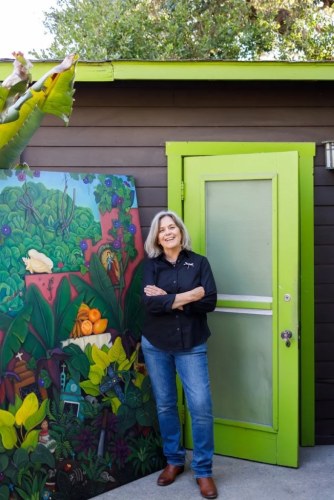
Angela Perko is a self-taught painter here in Santa Barbara. Angela and her husband own a rare bookstore, and she credits the exposure to art books for sparking her interest in painting.
Tell me a bit about the cover story art and the other two paintings that you made, currently on view at Sullivan Goss Gallery. What was the inspiration behind them?
“The Headless Man,” which was the first painting I made, was quite different than the images used for the festival posters in the past, which often featured architectural landmarks. I wanted to offer an architectural alternative. So, with the “Arlington Theatre” piece, I wanted to express something about the magic of the event. It’s a sort of Brigadoonidea. Once a year, for a very brief period of time, this event appears and magically transforms our city.
The idea behind the first poster, “The Headless Man,” was to illustrate how when we sit down to watch a film, our minds sort of disappear and we are transported to a different reality. The imagination steps in and takes us away. When I thought about a headless man, Magritte immediately came to mind; his work is often very graphic, but he creates these curious and magical environments, which was what I was looking for.
The last piece, “Rolling Out the Red Carpet” is a bit of a whimsical history of the film industry here in Santa Barbara, from the Flying “A” Studio to the present film festival. It was a bit of a puzzle, which was a fun challenge. I enjoyed reading Hattie Beresford’s history of The Granada Theatre, which prompted me to incorporate Charlie Chaplin and Felix the Cat in the design.
You talk a lot about how literature has an influence in your work. Can you describe how the stories come alive for you and how they reflect in your work?
Literature is indeed an important part of what I do. History, too. I don’t necessarily try to illustrate a story, though it does seem to happen sometimes. There’s an element of “stream of consciousness” to my work; words and phrases are the jumping-off point, then the imagery becomes more personal and imagined. I always hope that the paintings touch on something essential and timeless, like a good poem.
Tell me a bit about the Lost Horizon Bookstore. Do you ever go there for influence for your upcoming works?
Lost Horizon Bookstore has been a treasure trove for me as an artist. We have a large collection of art books, and particularly related to this project is the fact that we carry a tremendous number of vintage posters. So there was a lot for me to look at and absorb when making the poster designs. A used bookstore has a randomness about it; things you don’t expect come your way. I think that has had a great impact on my artistic choices.
Tell me about the process of teaching yourself art when you first started. Do you feel like it has given you a more intimate connection to the art you’ve created since?
The teaching of one’s self never ends. That’s what makes this vocation continually exciting and challenging. Each new idea or project often requires a new set of skills. I started as predominantly a landscape painter. Over the years, I’ve allowed myself to indulge in a more imaginative approach, to add not just that literary element, but my own personal philosophy and related iconography to the work.
Can you tell me about any art you’re currently working on? What is something you want to convey in your upcoming works?
One of the themes in my more mature work has been the idea of loss. Each technical and cultural advancement has come at a great cost. It’s not just the cost to our environment, though that may be the most significant, it is the loss of skills and imagination, observation and language, and stories and beliefs that also concern me. And objects … particularly those that were once full of magic and wonder, and are now mere curiosities, that are quickly disappearing as our lives become more virtual. That said, looking back and looking forward in time gives me great hope. My interior mindscapes are often infused with nature, both wild and cultivated. My next show will continue to include all these elements.